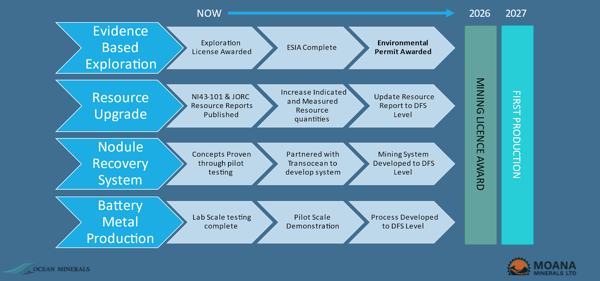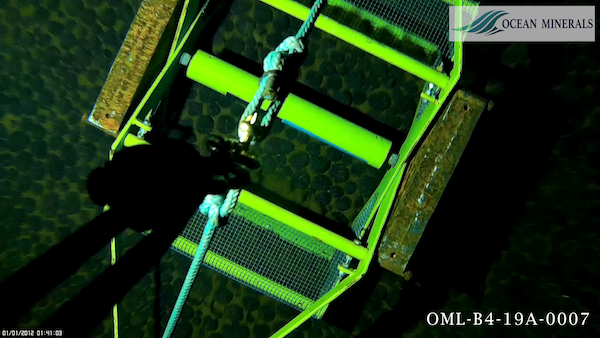The Cook Islands Nodule Project
Polymetallic nodules found on the abyssal plains of the Cook Islands EEZ represent one of the largest known cobalt deposits in the world, and hold promise to address huge shortages projected for this metal critical to meet the global decarbonization goals.
Polymetallic Nodules for Critical Metals Metals and Clean Energy TransitionNodule-based Critical Metal Production: A Real Solution

Moana Minerals’ Cook Islands Nodule Project
The nodules of the Cook Islands are unique in their shape, size, metal content, and setting when compared to nodules found elsewhere in the world. Our exploration program collects and analyzes data to complete a multi-year environmental baseline study and accompanying Environmental & Social Impact Assessment. These efforts quantify and fully characterize the environment and the nodule resource in our exploration area. Collected and analyzed engineering data (seabed, water column, air/water interface) informs the design of nodule recovery systems, ensuring efficient operations with minimal environmental disturbance.
Learn More About Our Environmental Program
Why the Cook Islands Nodules?
The nodule resource of the Cook Islands is extensive, constituting perhaps the largest primary cobalt ore body in the world. In addition to being extremely high grade (0.5%) in terms of cobalt, the nodules also contain significant levels of nickel, copper, manganese, iron and rare earth elements. The nodules themselves lie uncovered atop the seabed sediments, and this 2-dimensional deposit is extremely uniform in terms of grade and chemistry. Seabed mineral exploration laws and associated regulations are well defined, with mining regulations under development and broad bi-partisan and public support, making the Cook Islands an attractive regulatory regime.
Cook Islands Seabed Minerals AuthorityPath to Critical Mineral Production from CI Nodules
Multiple parallel research and development activities will be required to achieve critical minerals production from CI Nodules.
Path to Environmental Permitting
Environmental baselining is a critical activity, and information gathered will be used to update our Ecosystem model to allow us to understand cause and effect relationships between proposed future mining activities and portions of the ecosystem. Social impacts are also considered, and our program will include regular engagement with the Cook Islands community and other stakeholders to ensure we understand the risks and opportunities.
Expanding and Upgrading Resource to Indicated
The 1 million tonnes cobalt resource (inferred) is contained within only 40% of the total license area, with the remaining area estimated to contain an additional 1 to 1.5 million tonnes of cobalt. Our exploration program will sample over the entire license area, and will collect seabed imagery, bathymetry, and backscatter data all in support of expanding and upgrading our resource estimates from inferred and prospective to indicated and measured.
Engineering Efficient, Low-impact Nodule Recovery Solutions
Our partner Transocean brings to the project their extensive experience in deep water drilling design and operations and riser handling. They have surveyed the seabed mining equipment market to identify the most promising technologies, many of which are mature and have undergone pilot testing in environments approaching our operational depths. Their engineering team is developing an integrated nodule recovery system concept in support of Preliminary Feasibility assessment, a key milestone within Moana’s exploration program. This integrated system will include nodule pickup, lift to surface vessel, dewatering and transshipment to a remote site for processing, all with a focus towards performance and reliability and in support of commercial viability. In support of Transocean’s design work, our exploration program will collect critical data associated with seabed mechanical properties, nodule physical properties, seabed terrain, and water column and other oceanographic data.
Developing Optimized Metal Extraction & Recovery Process
Just recovering the nodules from the seabed is only half of the project. Being able to cost-effectively process the nodules to produce metals and metal compounds critical for the manufacture of battery and other green energy components/systems is just as critical. Our modified Cuprion process, as well as alternate techniques, must be proven at sufficient scale, in order to demonstrate a workable solution with understood economics and realizable options for implementation.
Mining Applications Follow 5 Years of Exploration
Applications for mining will hinge upon results from ESIA and follow-on request for Environmental Permit to move on to operations. Commercial viability as assessed during Preliminary Feasibility and Definitive Feasibility phases will also factor into decisions around future mining. Commercial viability assessment as part of Preliminary Feasibility and Definitive Feasibility studies will also factor into decisions around future mining, and will consider market factors associated with target metals, costs to build the nodule recovery/mining system and processing plant (CAPEX) and costs to operate these systems (OPEX).
Path to Environmental Permitting
Environmental baselining is a critical activity, and information gathered will be used to update our Ecosystem model to allow us to understand cause and effect relationships between proposed future mining activities and portions of the ecosystem. Social impacts are also considered, and our program will include regular engagement with the Cook Islands community and other stakeholders to ensure we understand the risks and opportunities.
Expanding and Upgrading Resource to Indicated
The 1 million tonnes cobalt resource (inferred) is contained within only 40% of the total license area, with the remaining area estimated to contain an additional 1 to 1.5 million tonnes of cobalt. Our exploration program will sample over the entire license area, and will collect seabed imagery, bathymetry, and backscatter data all in support of expanding and upgrading our resource estimates from inferred and prospective to indicated and measured.
Engineering Efficient, Low-impact Nodule Recovery Solutions
Our partner Transocean brings to the project their extensive experience in deep water drilling design and operations and riser handling. They have surveyed the seabed mining equipment market to identify the most promising technologies, many of which are mature and have undergone pilot testing in environments approaching our operational depths. Their engineering team is developing an integrated nodule recovery system concept in support of Preliminary Feasibility assessment, a key milestone within Moana’s exploration program. This integrated system will include nodule pickup, lift to surface vessel, dewatering and transshipment to a remote site for processing, all with a focus towards performance and reliability and in support of commercial viability. In support of Transocean’s design work, our exploration program will collect critical data associated with seabed mechanical properties, nodule physical properties, seabed terrain, and water column and other oceanographic data.
Developing Optimized Metal Extraction & Recovery Process
Just recovering the nodules from the seabed is only half of the project. Being able to cost-effectively process the nodules to produce metals and metal compounds critical for the manufacture of battery and other green energy components/systems is just as critical. Our modified Cuprion process, as well as alternate techniques, must be proven at sufficient scale, in order to demonstrate a workable solution with understood economics and realizable options for implementation.
Mining Applications Follow 5 Years of Exploration
Applications for mining will hinge upon results from ESIA and follow-on request for Environmental Permit to move on to operations. Commercial viability as assessed during Preliminary Feasibility and Definitive Feasibility phases will also factor into decisions around future mining. Commercial viability assessment as part of Preliminary Feasibility and Definitive Feasibility studies will also factor into decisions around future mining, and will consider market factors associated with target metals, costs to build the nodule recovery/mining system and processing plant (CAPEX) and costs to operate these systems (OPEX).